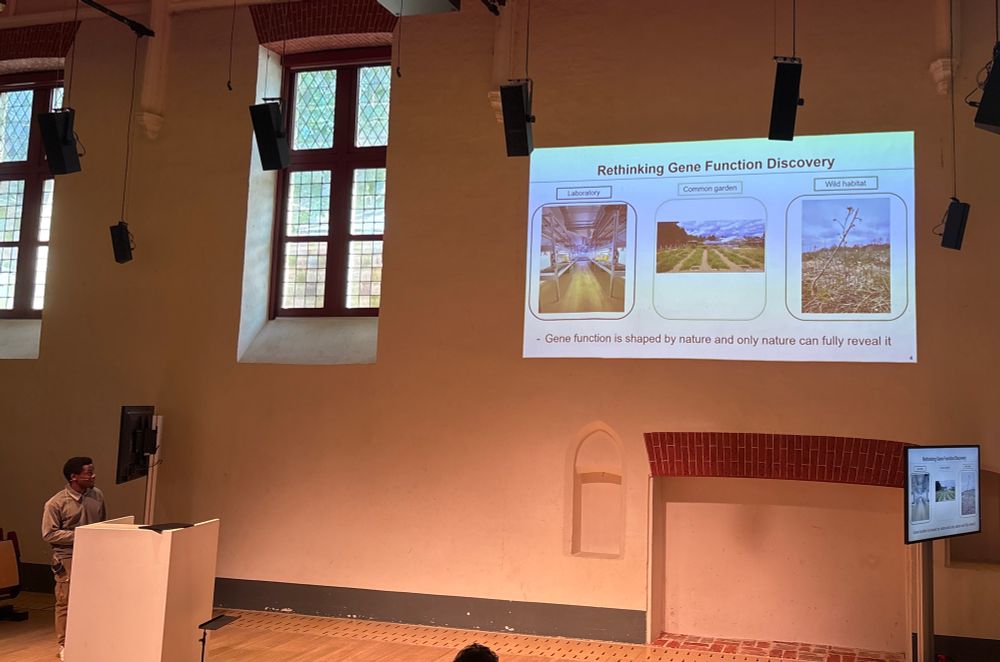
Eneza Mjema
@enezer.bsky.social
Bioinformatician || Plant transcriptomics, Gene functions and regulation and Machine learning || PhD candidate
Reposted by Eneza Mjema
Professorship in plant genetics.
The Botanical Institute at Kiel University is advertising a W2 professorship. Great opportunity to do plant research in the north of Germany. See:
www.berufungen.uni-kiel.de/de/dateien/o...
The Botanical Institute at Kiel University is advertising a W2 professorship. Great opportunity to do plant research in the north of Germany. See:
www.berufungen.uni-kiel.de/de/dateien/o...
www.berufungen.uni-kiel.de
October 12, 2025 at 9:01 AM
Professorship in plant genetics.
The Botanical Institute at Kiel University is advertising a W2 professorship. Great opportunity to do plant research in the north of Germany. See:
www.berufungen.uni-kiel.de/de/dateien/o...
The Botanical Institute at Kiel University is advertising a W2 professorship. Great opportunity to do plant research in the north of Germany. See:
www.berufungen.uni-kiel.de/de/dateien/o...
Reposted by Eneza Mjema
New PhD opportunity in my group @thesainsburylab.bsky.social through the BBSRC NRP DTP Programme - see details of host to apply below
biodtp.norwichresearchpark.ac.uk/projects/van...
biodtp.norwichresearchpark.ac.uk/projects/van...

Vanishing Virulence: Investigating pathogenicity loss in a plant pathogenic fungus (TALBOT_T26DTP) | Doctoral Training Partnership
What makes a plant killer lose its edge? This project will investigate why fungal pathogens lose virulence when they are grown in laboratory culture away from their host plant. Use cutting-edge…
biodtp.norwichresearchpark.ac.uk
October 12, 2025 at 5:20 PM
New PhD opportunity in my group @thesainsburylab.bsky.social through the BBSRC NRP DTP Programme - see details of host to apply below
biodtp.norwichresearchpark.ac.uk/projects/van...
biodtp.norwichresearchpark.ac.uk/projects/van...
Reposted by Eneza Mjema
Form follows function – structural interplay between DCL1 and pri-miRNAs #plantscience

Form follows function – structural interplay between DCL1 and pri-miRNAs
MicroRNAs (miRNAs) guide post-transcriptional gene silencing in plants and shape developmental outcomes and environmental responses by precisely tuning gene expression. miRNAs originate from primary transcripts (pri-miRNAs) whose structural features – including internal loops, mismatches, and sequence motifs – facilitate interactions with the miRNA processing complex composed of DICER-LIKE 1 (DCL1), HYPONASTIC LEAVES 1 (HYL1), and SERRATE (SE). In vitro structural analyses of DCL1, HYL1, and SE proteins have elucidated their interactions with each other and with pri-miRNAs at unprecedented resolution. These findings highlight plant-specific processing features that are distinct from those of animals and suggest new avenues for manipulating miRNA pathways. We review recent progress in understanding the structural determinants of pri-miRNA processing, knowledge that may also be valuable for future applications in crop species through targeted genome editing.
dlvr.it
September 15, 2025 at 6:50 PM
Form follows function – structural interplay between DCL1 and pri-miRNAs #plantscience
Reposted by Eneza Mjema
Our review in discusses how pri-miRNA and DCL1 structures shape plant microRNA biogenesis, and why collaboration between plant and protein scientists is key ☘️🤝
Form follows function – structural interplay between DCL1 and pri-miRNAs #plantscience

Form follows function – structural interplay between DCL1 and pri-miRNAs
MicroRNAs (miRNAs) guide post-transcriptional gene silencing in plants and shape developmental outcomes and environmental responses by precisely tuning gene expression. miRNAs originate from primary transcripts (pri-miRNAs) whose structural features – including internal loops, mismatches, and sequence motifs – facilitate interactions with the miRNA processing complex composed of DICER-LIKE 1 (DCL1), HYPONASTIC LEAVES 1 (HYL1), and SERRATE (SE). In vitro structural analyses of DCL1, HYL1, and SE proteins have elucidated their interactions with each other and with pri-miRNAs at unprecedented resolution. These findings highlight plant-specific processing features that are distinct from those of animals and suggest new avenues for manipulating miRNA pathways. We review recent progress in understanding the structural determinants of pri-miRNA processing, knowledge that may also be valuable for future applications in crop species through targeted genome editing.
dlvr.it
September 16, 2025 at 7:46 AM
Our review in discusses how pri-miRNA and DCL1 structures shape plant microRNA biogenesis, and why collaboration between plant and protein scientists is key ☘️🤝
Reposted by Eneza Mjema
New Review from our fellow @snp2prot.bsky.social members @saschalaubinger.bsky.social, Clara Schöder, Panos Kastritis and the excellent ECRs Cecille Scholl, Lars Grosch and Jana Baradei! Check it out: www.cell.com/trends/plant...

Form follows function – structural interplay between DCL1 and pri-miRNAs
MicroRNAs (miRNAs) guide post-transcriptional gene silencing in plants and shape developmental
outcomes and environmental responses by precisely tuning gene expression. miRNAs originate
from primary t...
www.cell.com
September 16, 2025 at 8:10 AM
New Review from our fellow @snp2prot.bsky.social members @saschalaubinger.bsky.social, Clara Schöder, Panos Kastritis and the excellent ECRs Cecille Scholl, Lars Grosch and Jana Baradei! Check it out: www.cell.com/trends/plant...
Great session with amazing talks! Using single-plant omics on naturally occurring (Wild) Arabidopsis populations is a powerful and underutilized approach for uncovering gene-phenotype relationships in an ecological context. #icar2025
Concurrent session 14: gene to phenotype prediction: Eneza Yoeli Mjema: approach: collect data from plants growing in natural habitats to find missing gene functions, use machine learning to look for gene-phenotype relationships @enezer.bsky.social
#icar2025
#icar2025

June 20, 2025 at 3:54 PM
Great session with amazing talks! Using single-plant omics on naturally occurring (Wild) Arabidopsis populations is a powerful and underutilized approach for uncovering gene-phenotype relationships in an ecological context. #icar2025
Exciting PhD position in an amazing team - highly recommend applying.
Are you interested in joining our team as a PhD student to explore telescripting in crops? Apply now! Deadline: December 25th.
www.verwaltung.uni-halle.de/dezern3/Auss...
www.verwaltung.uni-halle.de/dezern3/Auss...
December 11, 2024 at 7:10 PM
Exciting PhD position in an amazing team - highly recommend applying.

